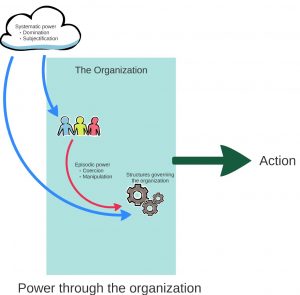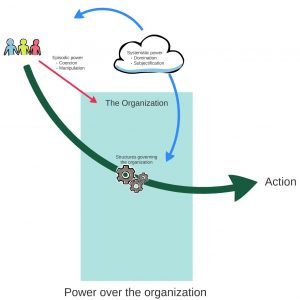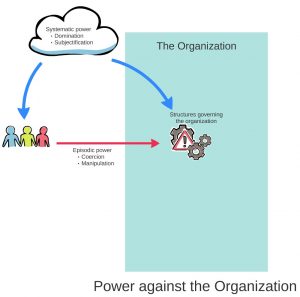Faces and sites of power
Brad C. Anderson
Peter Fleming and André Spicer developed a framework that sought to organize the vast collection of scholarly thought on power. Their model has two categories: faces of power and sites of power.[1]
Faces of Power
The faces of power describe the forms through which people experience power. As you read about these faces, you will see similarities between it and the dimensions of power described earlier. See if you can connect the faces of power described below to power’s dimensions discussed above.
Fleming & Spicer identified two faces of power: episodic and systematic.
The first face: Episodic power
You can think of episodic power as the direct exercise of power. It includes coercion and manipulation.
- Coercion is the use of power to compel another party’s compliance when they otherwise would not comply. What are the sources of power that give one party the ability to coerce another? There are several, including:
- Bureaucratic authority
- A psychological propensity to use force or threats
- A capability to reduce uncertainty
- Possession of valuable resources
- Manipulation is the use of power to control the topics people discuss and to frame the issues discussed within desired boundaries. The power to manipulate comes from several sources, including:
- The ability to manipulate rules of conduct
- Being able to define the outcomes that people expect
- Mobilizing bias for or against certain issues within an organization
- Influencing the process through which people make decisions
The second face: Systematic power
Whereas episodic power is the direct exercise of power to obtain the compliance of others, systematic power considers the web of power that creates organizing structures within our society. It includes domination and subjectification.
- Domination is the use of power to shape people’s preferences and influence their interests. Domination occurs through several means, including:
- Indoctrination into an organization’s culture
- Adopting the unquestioned assumptions that guide behaviour in a field of endeavour
- Adhering to an institution’s norms of operation
- Adopting those behaviours and beliefs that an organization perceives as legitimate
An Example of Domination
It can be tricky to wrap your head around the idea of domination. Let’s look at an example to clarify.
As listed above, the sources of domination included culture, unquestioned assumptions, norms, and behaviours/beliefs the organization sees as legitimate. How might this operate in, let’s say, a hospital?
The hospital’s organizational culture might value saving lives. It may pursue this value because this is what society expects hospitals to do–that is, saving lives is a legitimate pursuit.
Healthcare workers in that hospital adopt those values. Then, when a patient sees a doctor, the doctor assumes the patient wants to live longer. They then choose to perform actions to save that patient’s life.
Through these processes of domination, healthcare workers see saving lives as the natural course of action. Doing anything else is unimaginable.
- Subjectification is the process through which individuals obtain their sense of identity within a social system. By conforming to these identities, people perform specific actions, assume different levels of authority, and adopt prescribed beliefs and values. Subjectification occurs through several means, such as:
- Working in groups
- Monitoring of individual behaviour within a group
- Development of strategies that identify specific roles that individuals fill
- The creation of words and concepts that defines identities and functions (e.g., manager, cashier, teacher, student). Each of these words means something, and when you apply that title to yourself, you take on that meaning as part of your identity.
As mentioned earlier, there is an overlap between these faces of power and the dimensions of power the previous section described. The following table summarizes these areas of overlap.
Coercion intersects with the concept of one- and two-dimensional power. Power’s second dimension aligns with manipulation. Conversely, domination overlaps with the third- and fourth-dimensions of power, whereas subjectification overlaps with the fourth dimension.
| One-dimensional power | Two-dimensional power | Three-dimensional power | Four-dimensional power | |
| Coercion | + | + | ||
| Manipulation | + | |||
| Domination | + | + | ||
| Subjectification | + |
Sites of Power
In addition to describing the faces of power, Fleming and Spicer identified four sites of power surrounding the organization. These include power in, through, over, and against the organization.
- Power in organizations describes the efforts of individuals within an institution’s boundaries to affect its structures governing the organization. Examples include resisting change initiatives, conflicts between staff and their managers, dealing with whistleblowers, and so on.
- Power through organizations describes the efforts to use the organization to achieve an objective outside the organization. Examples include government or non-governmental agencies partnering with other institutions to pursue some political end.
- Power over organizations describes the efforts of influential individuals or groups to exert influence over an organization. Examples include shareholder activism, government regulators’ intervention, and lobbying by third-parties to change a business’s activities.
- Power against the organization describes the efforts of outside individuals or groups to create a change in the structures governing the organization. Examples include tapping into social movements to create change (e.g., women’s rights movement driving gender equity in salary structures and advancement opportunities within an organization)
The following series of figures visually represent the relationship between the faces of power and the sites of power in organizations.
The diagram below shows power in organizations. Individuals inside the organization use episodic forms of power as they contest each other to shape the structures governing the organization. Systematic power shapes the preferences and behaviours of individuals and the structures governing the organization.

The next figure shows power through organizations. Individuals inside the organization use episodic forms of power to drive the organization’s structures, creating the actions of the organization. Systematic power shapes the preferences and behaviours of individuals and the structures governing the organization.

The next figure shows power over organizations. Individuals outside the organization use episodic forms of power to drive the organization’s structures, influencing the actions of the organization. Systematic power shapes the preferences and behaviours of individuals and the structures governing the organization.

The next figure shows power against the organization. Individuals outside the organization use episodic forms of power to contest the organization’s governing structures. Systematic power shapes the preferences and behaviours of individuals and the structures governing the organization.

Key Takeaways
- Faces of power describe the forms through which people experience power. These faces include episodic and systematic power.
- Episodic power is the direct exercise of power, including coercion and manipulation.
- Systematic power is the web of power that creates organizing structures within social systems, including domination and subjectification.
- Sites of power define where power operates within organizations. It includes:
- Power in organizations
- Power through organizations
- Power over organizations
- Power against organizations
- Fleming, P., & Spicer, A. (2014). Power in Management and Organization Science. The Academy of Management Annals, 8(1), 237–298. ↵
Episodic power is the direct exercise of power. It includes coercion and manipulation.
Coercion is an form of episodic power. It is the use of power to compel another party's compliance when they otherwise would not comply.
Manipulation is a form of episodic power. It is the use of power to control the topics people discuss and to frame the issues discussed within desired boundaries.
Systematic power considers the web of power that creates organizing structures within our society.
Domination is a form of systematic power. It is the use of power to shape people's preferences and influence their interests.
Subjectification is a form of systematic power. It is the process through which individuals obtain their sense of identity within a social system.
The ability to get what you want from others through direct, open conflict
Obtaining what you want through suppressing conflict and limiting the scope of what is debated to issues you deem safe.
The ability to get what you want by influencing the preferences of others.
The dense web of power networks through which societies organize themselves.
Power in organizations describes the efforts of individuals within an institution's boundaries to affect the structures governing the organization.
Power through organizations describes the efforts to use the organization to achieve an objective.
Power over organizations describes the efforts of powerful individuals or groups to exert influence over an organization.
Power against the organization describes the efforts of outside individuals or groups to create a change in the structures governing the organization.

